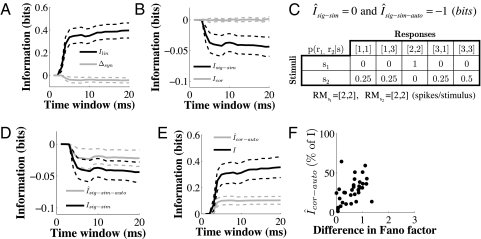Fig. 3.
Trial-to-trial response variability contributes to the redundancy between neurons. (A) Information carried independently by the individual neurons in each pair (linear term Ilin, black line), and information gained (synergy) or lost (redundancy) in their joint responses (synergy/redundancy term Δsyn; gray line). (B) Redundancy due to signal similarity (Isig-sim, black line) and synergy/redundancy due to noise correlations (Icor, gray line). (C) Simple example of a pair of neurons carrying redundant information in count autocorrelations. Both neurons independently fire always with two spikes in response to the first stimulus and either one spike or three spikes in response to the second stimulus. Shown is the joint conditional probability p(r1, r2 | s) of the responses of the neurons to the stimuli and the corresponding information values, assuming that p(s1) = p(s2) = 0.5. (D) Signal similarity due to count autocorrelations (Îsig-sim-auto, gray line), compared with the total signal similarity (Isig-sim, black line, same as in B). (E) Total information (Itot, black line) carried by pairs of neurons about stimulus location and information due to count autocorrelations (Îcor-auto, gray line). All x axes are as in Fig. 2C; solid lines are averages across neurons; dashed lines are 95% confidence intervals. (F) Scatter plot of the information due to count autocorrelations (Îcor-auto, y axis, expressed as percentage of the total information) versus the difference in Fano factor between stimuli (x axis) for pairs of neurons. The difference in Fano factor between stimuli for pairs of neurons was defined as the Euclidean distance between the vectors of Fano factors corresponding to each stimulus location.

